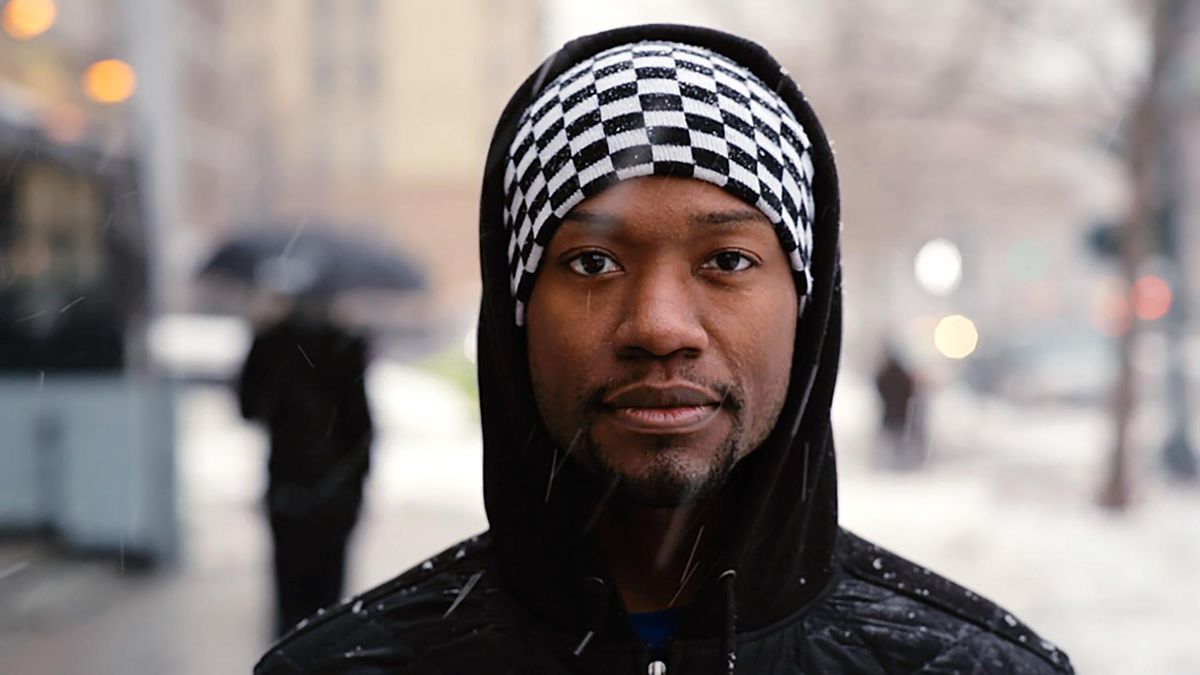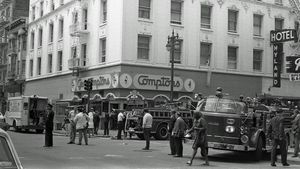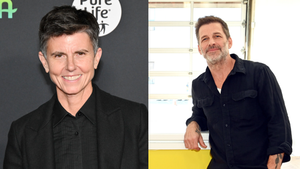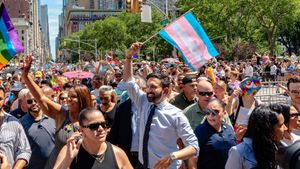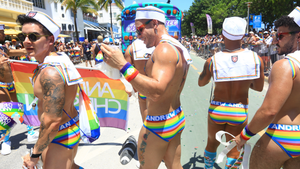Each one of us has the power to heal. Our bodies and spirits have a shared human language that can be accessed through the power of touch, movement, and joy. If done correctly, not only can we bring communities together, but we will also shift the trajectory of our culture.
The Ballroom community, made famous in the early 1990s by Madonna’s music video “Vogue” and the documentary Paris Is Burning, has been uniting subcultures long before the Queen of Pop brought it to MTV.
In the 1920s, Harlem balls were seen as a resistance to homophobia, transphobia, and the black church. As it transitioned into what we call “house ballroom” in the 1960s with the Terrible Five—the founding mothers that bridged drag balls with ballroom: Crystal LaBeija, Avis Pendavis, Dorian Corey, Duchess LaWong, and Paris Dupress—it became a resistance to racism and colorism.
The ballroom scene as it exists today can be viewed as a resistance to patriarchy, white supremacy, toxic masculinity, and all the layers of oppressive structures that exist in the system now.
But this generation is different. Within the ballroom community itself rose an activist subculture called the “Kiki Scene,” which began over a decade ago by young people accessing programming at the Gay Men’s Health Crisis, a New York City-based organization that provides health and housing information and resources to communities disproportionately affected by homelessness, HIV, and AIDS.
Kiki is a youth-led component of the larger ballroom scene. Run by LGBTQ youth for LGBTQ youth, members range from young teens to 20s, and for many of them who’ve been thrown out of their families, house members are more than friends. They’re the only family they know.
Ballroom performers belong to select houses, each founded by a different house “parent.” And not all houses are the same. In fact, each of them have their own uniqueness—some lean towards education, others lean towards relationships, family values, or community services. But all are motivated with a singular vision to shape each member into a person of character.
Twiggy Pucci Garçon is founder of the Kiki scene’s largest international house, the Opulent Haus of PUCCI, which promotes personal and professional development and targets community service initiatives within its communities. For him, mentoring has become more than just a duty. It’s destiny.
“I always say that there are three things I know I’m qualified to do,” he says to Plus. “I’m an empathy, an intuit, and a healer. I’m able to feel what other people feel. I’m able to see things in a certain way. I’m able to help people realize and bring them into a place that they heal for themselves and improve themselves.”
It was Garcon’s intuitiveness that inspired him and his best friend, renowned mentor and Founding Mother and creator of the House of Unbothered-Cartier and Empress of the Legendary House of Mizrahi, Chi Chi Mizrahi, to do a project focusing on the Kiki scene.
Destiny, as it were, appeared in the form of Sara Jordenö, who happened to be using the offices of Faces of New York (a community-based organization in Harlem both Garcon and Chi Chi were working for at the time). After collaborating for many weeks, the trio decided to do a full-length documentary, with Sara as director and Garcon as co-writer.
The finished product is Kiki, one of the first movies to highlight the ballroom scene since Paris is Burning in 1990.
“We wanted this to be a collaboration not just for Sara and me, but with the whole community,” Garcon says nostalgically. What he wanted most from the film is for black and brown, queer and trans folks to see themselves and know that anything is possible—something he searched for as a teenager growing up in Virginia.
It’s hard to believe it’s been 13 years since Garcon’s first ballroom. After lying to his mom, telling her he was going to a “runway competition,” he traveled to nearby Richmond, Virginia, with a high school friend who was openly gay and often vogued in their high school hallways between classes).
“It was around Halloween that year and he was like, ‘You compete, you do this, you do that, and so you should come,’” Garcon remembers. The two had also known each other through various dance competitions in the area.
“We went to the ball and I was taken aback by how many black people were there all in one space celebrating one another. It was quite overwhelming,” he continues. “I was nervous and didn't want to compete; I still did. I didn't know the difference between the runway and styles of runway and walks, so I went back to the drawing board. That same night was also the night I met the person who became my first gay “father” and mentor in the scene. From him and the members of my first house, which is the house of Chanel, teaching me runway, two months later I walked again and won runway.… And I never stopped.”
The film Kiki follows seven characters from the Kiki community over the course of four years, spotlighting their performances amidst their battles with homelessness, prejudice and a passion towards influencing culture through individual expression.
“I was incredibly impressed with the individuals and the scene,” Jordenö says. “People share their struggles, but also their victories, in this beautiful way, as I interpreted it, to be able to lift each other up and to grow. People are saving each other's lives in the scene.”
The New York City and Gothenburg-based director was a longtime feminist, but was slowly loosing her faith in activism prior to shooting the film. After meeting people in the Kiki scene, she says her spirit was reignited. “There’s so much to learn,” she says. “I think the film should inspire a lot of communities, not just LGBT communities. I feel like we can look to the Kiki scene and ballroom community and be able to see the challenges we have today.”
For those who are alone and feel compounded by institutions that fail us, finding a family and searching for community is almost a requirement to survive. The Kiki scene provides more than a place of solitude. It’s a reminder that creative expression is a pathway to the soul, and ultimately inner freedom.
“What brings us together are our issues, but what keeps us together is the joy,” adds Gia Marie Love, Queen Mother of the House of Juicy and one of the stars of Kiki. “We center the Kiki scene around the HIV/STD narrative and people being vulnerable, but a lot of people come to the scene because of the joy. They [already] live the issues. They're homeless. They're being abused in many different ways. So when they come to the space, they can be. They can use it as an outlet to express in an artistic way what's going on with them in their lives.”
Using the human body as a canvas for expression requires us to be introspective, which is encouraged by everyone in the scene. Love shares an experience when she was in Norway teaching a few girls how to vogue. “Why can’t we vogue like you?” the asked.
“I said, ‘It’s not that you can’t,’” Love explains. “When I learned how to vogue they said I can’t teach it. You have to learn it, because your vogue is from your own experience. We learn from our pain and suffering. You release it. That was my advice to them: Vogue with passion. Vogue from your core.”
When the Kiki scene started, one of its main missions was to spread HIV awareness to LGBT youth, an underserved demographic. The majority of people in the scene are largely impacted by the virus, and use their shared knowledge to start important discussions.
“I’ve lost over 25 personal friends and family from complications due to AIDS,” Garcon says. “It's affected me very emotionally, very deeply. And also, I'm not a very pessimistic person so moments of loss drive me to continue doing the work I'm doing. It's definitely been a powerful experience but it's also an empowering experience to know it's important for not just me, but the community.”
Another important aspect of the scene is to poz youth with HIV-negative youth, to show that unity is the best form of therapy. But educating people on sex health, treatment, and prevention is easily stunted by stigma.
“I think that the social stigma around PrEP and related things is detrimental to the progression of us and to all communities impacted and infected with and by HIV,” Garcon points out. “And also homelessness. There's social stigmas for that. I feel that if people cannot talk openly about what they're going through, then how do we heal through the experience? How do we transform the experience to be one of healing and progression? The tide is turning because more people are aware of the importance of PrEP, and of housing. There's treatment, there's prevention. PrEP specifically has a lot to do with people being more sex positive and not slut shaming. People have sex, that's a real thing. And if people want to have sex with no condoms then they should be able to do that. And do it in a way that's preventative of other things.”
Gia, an HIV and LGBT advocate, who is trans herself, has worked to provide specific data for the Centers for Disease Control and Prevention for it to better understand diagnoses rates not only among men who have sex with men, but also the trans community as a whole.
“The CDC groups trans women with MSM. [As a result] our numbers are conflated,” she explains. “The funding that [CDC] is giving are for men who have sex with men and that's a barrier to accessing care for trans women. It's triggering… Anyone's involvement in the Kiki scene, they're getting educated about HIV and STDs incorporated in the ballroom performance. There'll be a category that says, ‘Create a HIV STD campaign in a creative way.’ For example, you'll have people using social media, media graphics to create these campaigns to help educate each other about HIV and STDs. That's the type of advocacy I've done.”
The motto “Not About Us Without Us” is often used in the Kiki scene to describe the need for policy makers and government leaders to include members of the LGBT community in the conversation before assessing their needs. It is a statement borrowed from the movement of disabled activists, but the message is exactly the same.
“It’s a statement that, quite simply, means there shouldn’t any conversation happening about any of us without those folks being at the table in a meaningful and engaging way,” Garcon says. “When you talk about disabled folks, when you talk about people living with HIV and AIDS, or you talk about folks who’s experienced housing issues and homelessness, or you talk about the ballroom scene, there shouldn’t be a project created for and about those people without them being at the table. And not just at the table but having power.”
If there’s one project showing the power of involvement, it’s Kiki. “I want people to feel enraged. I want them to feel hopeful. I want them to feel pride. I want them to feel intellectually stimulated,” Jordenö says about the audience’s reaction. “I want to change their perspective. I want people to feel recognition, to recognize themselves. I want people to feel incredible joy and want to dance and move and use their body to express themselves. Not just the body, but your words. It's self-empowerment. I want people to feel that.”
If the film can teach us anything, it might show us a glimmer of hope into future coexistence, to help us celebrate one another so that we may heal from traumas and move forward in prosperity.
“I wish people would see themselves [in Kiki] and see a world that doesn't have to exist in this very oppressive way,” Garcon adds. “And that we can heal from our troubles, and we can dream of things, and think of things, and say a thing, and do it. Really manifest our own realities.”
